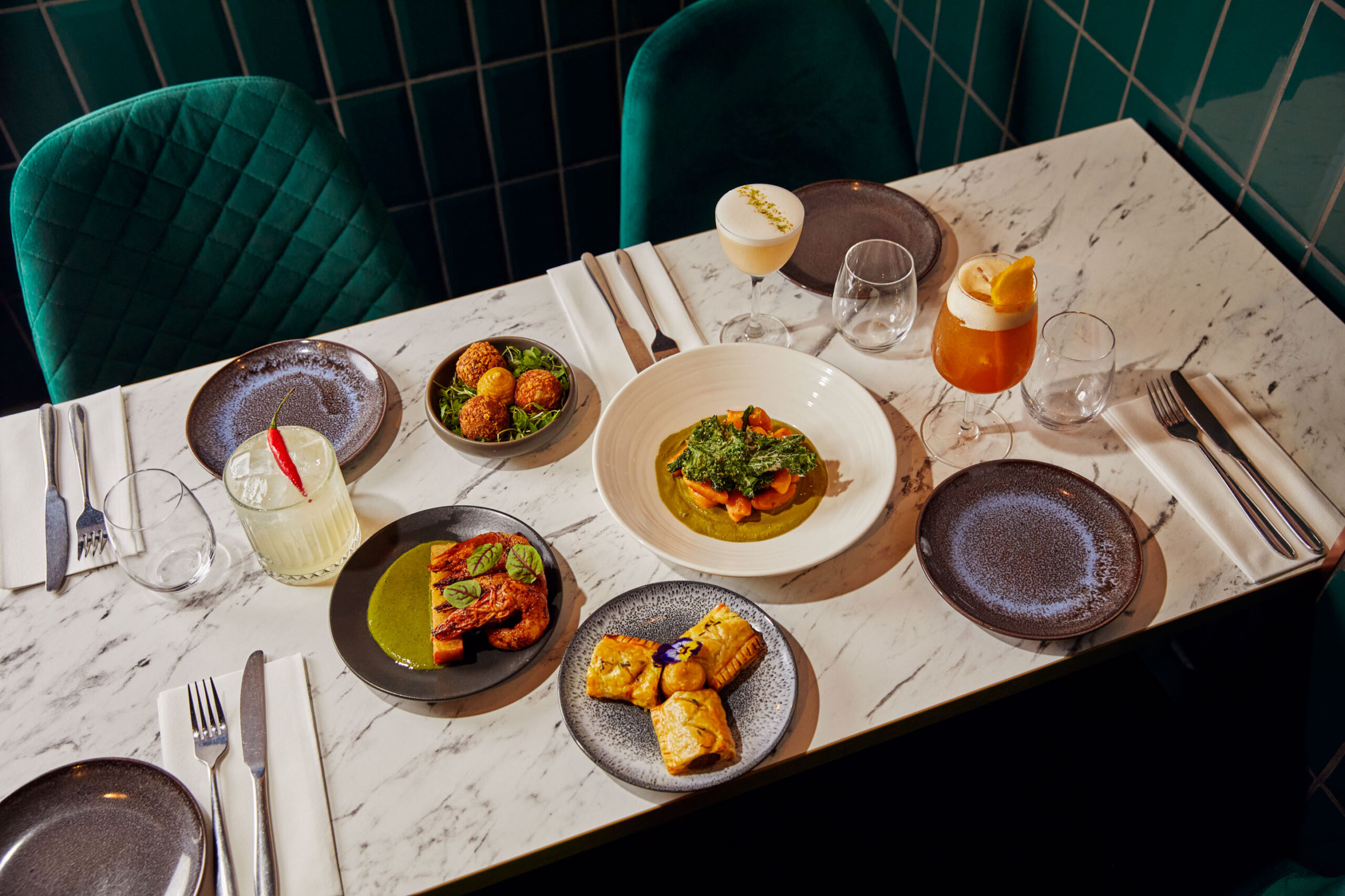From elegant hotel dining rooms to rum punch afternoon teas, there’s a new creative energy in West Indies dining. And a long history behind it.
For more than 150 years, the Palm Court has been renowned in London for its swanky high tea. The soaring, chandelier-decorated space in the West End’s Langham was the first grand hotel to offer the afternoon service back in 1865.
Over the past summer, Palm Court became home to a different sort of revolutionary meal. In July, Good Front Room, a modern Jamaican dining experience, launched for four nights weekly in a space whose walls are decorated with vibrant art, with dramatic spot lighting on tables that have been stripped of white cloths. The long-term residency is hosted by Dominic Taylor, winner of Channel 4’s Five Star Kitchen.
Against a solid 1970s R&B soundtrack, the chef serves a £75 ($92) set menu with remixes of classics like juicy jerk chicken dressed up with plantain jam and blackened-corn dressing. Its popularity has caused the restaurant to extend service to five nights a week, and its run will continue through April 2024. Seats sell out quickly.

Chef Dominic Taylor at The Good Front Room.
Taylor can trace the roots of Good Front Room back to the late ’50s, when several of his family members, including great-grandparents Velsie and Emmanuel Lee, left Jamaica for West Yorkshire in England’s north. (Emmanuel Lee sold a cow to help fund the trip.) They were part of the so-called Windrush generation that, starting in 1948, entailed thousands and thousands of colonial residents moving from the West Indies at the British government’s invitation to help build the UK’s postwar economy.
“My great aunt Myrtle [Walker, also from Jamaica], who the restaurant is inspired by, was part of the Windrush generation,” says Taylor. (In 2010, it was revealed that the government had destroyed the Windrush landing cards that affirmed their legal residence in the UK, impeding access to health care and benefits.)
For newly arrived families like Taylor’s, food from their hometowns—jerk chicken, beef patties—served as a powerful way to acclimate in the face of discrimination. In his 2016 book, Belly Full: Caribbean Food in The UK (Tezeta Press; £23) Riaz Phillips, a UK-based author and documenter, charts the role of these immigrant restaurants as community hubs in London, Manchester and Nottingham. He highlights the crucial role played by the Mangrove, a restaurant near London’s Notting Hill Carnival site, in the organization of Black activism in the 1970s and ‘80s in the UK. Famous customers included Jimi Hendrix, Nina Simone and Bob Marley.
The food at those early UK Caribbean eateries was, says Phillips, “conservative.” To appeal to a wide range of customers, proprietors served the most obvious dishes, which also made an easier sell to potential backers.
This changed over the past decade as diners took to traveling distances for food they labeled “authentic.” Meanwhile, social media has been “giving people a huge audience to leverage into financial opportunities such as crowdfunding,” Phillips adds.

Wood & Water founder April Jackson.
Among the London chefs reimagining classic Caribbean dishes is April Jackson, founder of Wood & Water, a convivial bar and restaurant in Brixton. She uses a creative menu of small plates “to push the boundary even further in terms of how we perceive Jamaican food.” The former BBC Apprentice star uses curry goat to stuff crispy croquettes and sausage rolls, accompanied by plantain butter. The desire to get away from clichés extends to decor; unlike many Caribbean places plastered with national flags and posters of Bob Marley, Jackson wants to show a “Jamaica that didn’t have Bob on the wall.” She has opted for a simple tropical decor.
Another boost for the Caribbean culinary wave comes from great drinks. In large part, such places as the ever-expanding Turtle Bay chain helped draw crowds to its boisterous outposts with cocktails. A rise in boozy Jamaican brunches across London has come as more operators focus on rum. One of them is Jackson, whose her new, cocktail-focused SideChick in Brixton offers options like the Portmore, made with fat-washed rum and coconut. “Drinks are very important in order to tell a more complete story of Jamaican cuisine,” she says.
Phillips, who just released a second book, East Winds: Recipes, History and Tales from the Hidden Caribbean, also credits the trend in plant-based dining with helping drive the popularity of Caribbean restaurants. “Veganism has always existed in the Caribbean through rasta culture, but it was always very niche,” he says. “Now, however, it’s growing in stature every year.”

Safiya Robinson at her SisterWomanVegan residency at Moko.
Among the plant-based practitioners is Safiya Robinson, who runs the popular new SisterWomanVegan residency at Moko in North London. She finds cultural importance in this moment for the UK’s Caribbean food scene as generations— shaped in part by their experiences as Black Britons—“are fighting back against cultural erasure with creative new ways to market, elevate and share the cuisine.”
The trend toward thoughtfully creative Caribbean food extends to the US. Darian Brian, executive chef and owner of the ambitious Bratts Hill in Buffalo, says West Indies restaurants are “having a moment, but it’s not just a passing trend.” Brian says consumers are increasingly looking for “diaspora cuisines,” especially in fine dining. “We’re one of the first fully Jamaican fine dining restaurants, but we definitely won’t be the last,” he declares.
Still, we’re here today to spotlight food in London. The places that follow demonstrate the range and energy of Caribbean food and drinks in the UK capital. Read on to learn more about seven of the best spots.

Curry goat sausage rolls, prawns, sweet potato gnocci at Wood & Water.
In Brixton, the city’s hub for Caribbean cuisine, Wood & Water is distinguished by its expert menu of both cocktails and small plates. Chef-owner Jackson, a former Miss Jamaica, has a tagline for it: “Modern British with Jamaican soul.” The attractive space evokes a jungle, with giant leaves on the wall and plush, gold-accented green chairs. Along with standout curry goat sausage rolls with a filling of sweet-spiced meat in flaky crust are peppery prawns on a bed of bright chimichurri sauce with cassava chips. For vegetarians, Jackson offers tender-chewy sweet potato gnocchi with an earthy callaloo pesto.
A strong list of cocktails, which go for £11 to £12, is dominated by rum concoctions such as the smoky Three Little Birds, made with spiced and overproof rum and pomegranate molasses. The sparkling wine-infused 1977 contains cocoa, lime and mint.

Menu items from SisterWomanVegan include the Rudeboy sandwich and Green and Gold.
SisterWomanVegan, also known as Safiya Robinson, is on a mission to promote creative, plant-based dishes. She’s currently doing that as the chef-in-residence at Moko, a cozy listening bar with walls of vinyl records and a restaurant in Tottenham. Her self-described “soul food with Caribbean influence” reflects the London-born cook’s dual African-American and Caribbean heritage. The menu is stocked with dishes like the best-selling Rudeboy Sandwich stuffed with cornmeal-fried oyster mushrooms and slathered with spicy ackee remoulade. The Green and Gold is a combination of cheesy grits next to jerk-grilled mushrooms and hibiscus Scotch bonnet chili oil.

Ackee and saltfish at The Good Front Room.
Chef Taylor has turned the Langham’s Palm Court into a five-night-a-week party. A buzzing, dressy crowd fills a room decorated with colorful portraits from Afro-Futurist painter Caroline Chinakwe. (Taylor helped curate.) He garnishes slow-braised pork belly with salted thyme cracklings and pickled raisins; he also turns green bananas into a gratin with nutmeg cream. Another Taylor remixed dish is ackee and saltfish, which combine the savory, boiled fruit with salt cod (widely regarded as Jamaica’s national dish), into a crisp, cylindrical seafood cake. The bar turns out drinks that fit the dining room’s party vibe: Caribbean Queen is a simple, potent mix of tequila, tamarind and salt caramel.

Diners at Danclair’s Kitchen where the restaurant features a colorful mural of his Venezuelan grandmother.
Set in one of the many food halls crisscrossing Brixton is the colorful Danclair’s Kitchen, which opened in August 2021. Chef-owner Brian Danclair showcases his Trinidadian roots in an intimate space decorated with a bright mural of his Venezuelan grandmother. The short, sharp tapas-concept menu invites diners to sample most dishes, such as the sensational cod fish fritters—fried golden and crisp and not too greasy—and barbeque wings with sticky guava glaze. Tina’s chicken empanadas, as they are known here, are studded with chunks of meat in a fried brown crust. The punch is made with copious amounts of Wray & Nephew rum.

The Caribbean Afternoon Tea tower at Rhythm Kitchen.
In North London’s Walthamstow, Rhythm Kitchen is run by Delroy Dixon, affectionately known as the “Jerk Father.” His wife Ann, who also co-owns the place, introduced the Caribbean Afternoon Tea experience last year. It is a simultaneously elegant and over-the-top affair that mixes classic tea options like Earl Grey and English breakfast with such pours as sorrel and ginger or soursop and moringa. The tea stand is stocked from the bottom with savory items like mango-glazed jerk chicken wings and sweet roasted plantain kebabs. Above sit buttermilk scones that are served with unconventional spreads like nutmeg and pineapple jam. The top layer of desserts includes little, rum-doused cakes and white chocolate brownies. The tea costs a little less than £40. Cocktails, which you can take in-house or in a to-go cup, include rum punch and a colorful slushie.

Doubles, a stretched and fried flatbread with spiced chickpeas, is a staple menu item at Limin’ Southbank.
Limin got its start as a rum-fueled beach club, first in Spitalfields and then in Southbank. In April, founder Sham Mahabir redesigned the space and added a retractable roof to make it a year-round place to hang out alongside piles of sand that still evoke a tropical party. “I wanted it to be very much Ibiza meets the Caribbean,” Mahabir has said. For weekend brunches, DJs blast reggae, soca and house music to promote a social atmosphere. Limin punch mixes the house rum with guava juice and passionfruit juice; the daiquri has a splash of hibiscus and cardamom syrup. The food is served in substantial portions and pays homage to the kind of comforting Trinidadian dishes that you find at Notting Hill Carnival, such as doubles—the stretched and fried flatbread that sits underneath spiced chickpeas and is served with hot pepper sauce.

Caribbean classics at Turtle Bay including jerk chicken and curry goat.
In 2010, Ajith Jayawickrema and Crispin Twedell opened the original outpost of Turtle Bay, now the UK’s most recognizable Carribean food and drink dynasty, in Milton Keynes, about an hour’s drive from London. Soon, they were expanding across the country, alongside Rum Kitchen and Levi Root’s Caribbean Smokehouse, helping bring Caribbean food and drinks into the mainstream. Today, Turtle Bay has 50 locations across the country: The latest opened in Hammersmith this year.
Decor at Turtle Bay is unapologetically Jamaican. The walls feature big pictures of Bob Marley and posters of Wray & Nephew rum bottles. Dishes don’t stray far from well-known classics like jerk chicken, curry goat and brown chicken. The restaurant offers an interesting mix of cocktails such as the Kingston Solero, a mix of white rum, mango, passionfruit, coconut milk and a dash of vanilla.
More On Bloomberg
Source link








